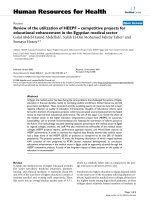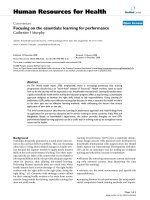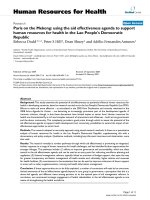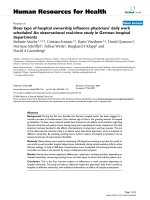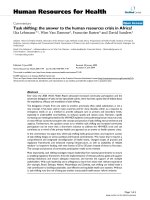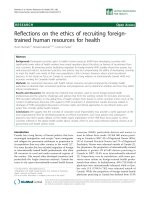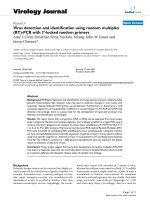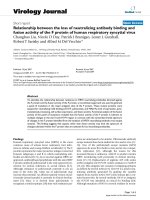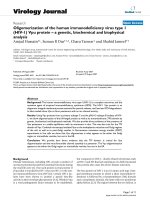báo cáo sinh học:" Paris on the Mekong: using the aid effectiveness agenda to support human resources for health in the Lao People''''s Democratic Republic" pdf
Bạn đang xem bản rút gọn của tài liệu. Xem và tải ngay bản đầy đủ của tài liệu tại đây (803.56 KB, 11 trang )
BioMed Central
Page 1 of 11
(page number not for citation purposes)
Human Resources for Health
Open Access
Research
Paris on the Mekong: using the aid effectiveness agenda to support
human resources for health in the Lao People's Democratic
Republic
Rebecca Dodd*
1,2
, Peter S Hill
2
, Dean Shuey
1
and Adélio Fernandes Antunes
1
Address:
1
World Health Organization, Geneva, Switzerland and
2
School of Population Health, The University of Queensland, Herston,
Queensland, Australia
Email: Rebecca Dodd* - ; Peter S Hill - ; Dean Shuey - ; Adélio Fernandes
Antunes -
* Corresponding author
Abstract
Background: This study examines the potential of aid effectiveness to positively influence human resources for
health in developing countries, based on research carried out in the Lao People's Democratic Republic (Lao PDR).
Efforts to make aid more effective – as articulated in the 2005 Paris Declaration and recently reiterated in the
2008 Accra Agenda for Action – are becoming an increasingly prominent part of the development agenda. A
common criticism, though, is that these discussions have limited impact at sector level. Human resources for
health are characterized by a rich and complex network of interactions and influences – both across government
and the donor community. This complexity provides a good prism through which to assess the potential of the
aid effectiveness agenda to support health development and, conversely, possibilities to extend the impact of aid-
effectiveness approaches to sector level.
Methods: The research adopted a case study approach using mixed research methods. It draws on a quantitative
analysis of human resources for health in the Lao People's Democratic Republic, supplementing this with a
documentary and policy analysis. Qualitative methods, including key informant interviews and observation, were
also used.
Results: The research revealed a number pathways through which aid effectiveness is promoting an integrated,
holistic response to a range of human resources for health challenges, and has identified further opportunities for
stronger linkages. The pathways include: (1) efforts to improve governance and accountability, which are often
central to the aid effectiveness agenda, and can be used as an entry point for reforming workforce planning and
regulation; (2) financial management reforms, typically linked to provision of budget support, that open the way
for greater transparency and better management of health monies and, ultimately, higher salaries and revenues
for health facilities; (3) commitments to harmonization that can be used to improve coherence of donor support
in areas such as salary supplementation, training and health information management.
Conclusion: If these opportunities are to be fully exploited, a number of constraints will need to be overcome:
limited awareness of the aid effectiveness agenda beyond a core group in government; a perception that this is a
donor-led agenda; and different views among partners as to the optimal pace of aid management reforms. In
conclusion, we recommend strategic engagement of health stakeholders in the aid effectiveness agenda as one
means of strengthening the health workforce.
Published: 25 February 2009
Human Resources for Health 2009, 7:16 doi:10.1186/1478-4491-7-16
Received: 27 September 2008
Accepted: 25 February 2009
This article is available from: />© 2009 Dodd et al; licensee BioMed Central Ltd.
This is an Open Access article distributed under the terms of the Creative Commons Attribution License ( />),
which permits unrestricted use, distribution, and reproduction in any medium, provided the original work is properly cited.
Human Resources for Health 2009, 7:16 />Page 2 of 11
(page number not for citation purposes)
Background
Human resources for health (HRH) are characterized by a
rich and complex network of interactions and influences
– both across government and the donor community.
Workforce planning and recruitment are influenced by
public administration systems; salary rates and conditions
for health workers intersect with those of the broader civil
service; and pre-service vocational training, in-service
training and continuing professional development engage
stakeholders not only in education, but also in trade and
foreign policy. At a higher level, whole-of-government
agendas such as poverty reduction, decentralization and
privatization also influence the profile, regulation and
deployment of the health workforce. This complexity pro-
vides a good prism through which to assess the potential
of the aid effectiveness agenda to support HRH develop-
ment. This in turn gives us an insight into the dynamics of
the development process and opportunities for aid man-
agement reform.
The Paris Declaration on Aid Effectiveness [1] has been
endorsed by more than 100 developing and developed
countries as well as by key multilateral agencies, the inter-
national finance institutions and civil society organiza-
tions. It sets out principles to guide donor support built
around the three pillars of the aid effectiveness agenda:
harmonization and simplification of donor policies and
procedures; alignment behind national priorities and use
of country systems; and a focus on results as measured in
improved development outcomes. Support for the Paris
Declaration was recently reiterated at the Third High-Level
Forum on Aid Effectiveness, a meeting of development
partners and developing countries held in September
2008, though stakeholders also noted a range of chal-
lenges to its implementation. Among these were the need
to broaden the range of actors in government involved in
aid effectiveness processes and to intensify efforts to apply
aid effectiveness approaches at sector level [2].
This study examines the potential of aid effectiveness to
positively influence HRH in developing countries, based
on research carried out in the Lao People's Democratic
Republic (hereafter the Lao PDR). The capital of Lao PDR
is Vientiane. On the banks of the Mekong River, with its
broad boulevards and distinct French colonial heritage, it
gives its name to a localized version of the Paris Declara-
tion: the Vientiane Declaration, signed in September 2006
by 23 partner countries and organizations providing aid
to the Lao PDR.
According to the Organisation for Economic Co-opera-
tion and Development (OECD), donors committed USD
36.7 million to health in the Lao PDR in 2005, and USD
20.8 million in 2006 (Table 1, also Additional File 1).
These figures are in line with those published by the Gov-
ernment of the Lao PDR, which recorded disbursements
of USD 36.6 million to health in financial year 2005–
2006 [3]. OECD lists 173 separate health or population
"activities" (in OECD terminology) for Lao covering the
period 2001–2006, with a median value of USD 0.23 mil-
lion. In general, an "activity" signifies allocation of funds
to a specific project or programme. However, donors
sometimes choose to report at a more detailed level, in
which case a "reported activity" may represent a compo-
nent of a project. But there are also cases where activities
are aggregated, so a single "reported activity" can be the
sum of several activities.
The largest entry for this period was a USD 15.9 million
grant from the Global Fund to Fight Aids, Tuberculosis
and Malaria (GFATM) for infectious disease control, but
the majority were for much smaller amounts, with 134 of
the 173 activities having a value of less than USD 1 mil-
lion dollars. This suggests a high degree of fragmentation
in donor support, and quite high transaction costs for gov-
ernment in managing many separate activities. Activities
are classified broadly – for example, as "basic health care"
or "reproductive health care", thus it is not possible to dis-
aggregate specific amounts spent on human resources for
health.
This level of donor support is low in comparison to many
other low-income countries [4], but it is still three times
higher than government spending. Per capita health
expenditure was estimated at USD 22 per capita in 2006,
of which 75% comes from households [5]; of public
expenditure, between 70% and 75% is financed by
donors, the remainder by government [6]. Further, the
landscape of health donors is complicated: Japan, Luxem-
bourg and the GFATM are the major contributors, but
there are 12 other bilateral donors active in health as well
as the European Commission, World Bank, Asian Devel-
opment Bank and various United Nations agencies. This
points both to the importance and influence of external
support in the sector and to the synergies offered by the
aid effectiveness agenda in making optimal use of limited
resources.
Methods
This research adopted a case study approach using mixed
research methods. It drew on a quantitative analysis of
HRH in the Lao PDR undertaken by the World Health
Organization (WHO) and the Ministry of Health (MOH)
[7], supplementing this with a documentary and policy
analysis, examination of the academic literature, govern-
ment and donor agency policy, reports and publications,
unpublished research and reviews. Qualitative methods,
including key informant interviews and observation,
focused on the potential linkages between HRH and the
aid effectiveness agenda.
Human Resources for Health 2009, 7:16 />Page 3 of 11
(page number not for citation purposes)
A total of 23 key-informant interviews were conducted.
Stratified selection was used to ensure a balance of
informants across ministries of health and finance, the
Public Administration and Civil Service Authority
(PACSA) and development partners. All major partners
active in health and human resources development were
interviewed: the Asian Development Bank, European
Commission, France, Japan, Luxembourg, the Joint
United Nations Programme on HIV/AIDS (UNAIDS), the
United Nations Development Programme (UNDP), the
United Nations Population Fund (UNFPA), the United
Nations Children's Programme (UNICEF), WHO and the
World Bank, as well as major non-governmental organiza-
tions (NGOs). Information on the GFATM activities was
collected from its web site, and via those partners active in
the Country Coordinating Mechanism, which oversees
GFATM activities.
The question guide used during the interviews was devel-
oped prior to the field component, and reviewed by col-
Table 1: Health aid commitments to the Lao PDR (USD, millions) (See Additional File 1)
2001 2002 2003 2004 2005 2006 Total
Australia 13.67 0.19 0.08 1.53 0.59 0.19 16.25
Belgium 0.84 0.77 0.77 0.43 1.18 1.43 5.42
Canada 4.31 0.50 0.04 4.85
France 0.35 0.59 1.25 1.49 1.46 1.90 7.04
Germany 1.27 0.50 0.57 2.34
Ireland 0.11 0.11
Italy 0.04 0.04
Japan 2.66 5.31 9.82 5.42 10.10 33.31
Luxembourg 0.48 9.17 4.19 3.58 2.20 19.63
New Zealand 0.01 0.48 0.49
Norway 0.10 0.06 0.05 0.21
Sweden 1.92 0.00 1.08 3.00
United Kingdom 0.56 0.56
United States 2.03 2.11 0.68 0.00 4.82
EC 2.23 0.97 3.20
GFATM 19.67 7.48 27.15
IDA 15.00 1.13 16.13
UNAIDS 0.23 0.24 0.17 0.28 0.93
UNFPA 2.48 2.28 1.47 6.22
UNICEF 1.20 0.94 0.79 0.97 1.10 1.52 6.52
Total 23.40 15.39 41.76 20.26 36.65 20.77 158.23
Source: Creditor Reporter System, OECD/DAC
Human Resources for Health 2009, 7:16 />Page 4 of 11
(page number not for citation purposes)
leagues working on HRH in WHO Geneva. Two
interviewers (RD and PSH) attended each interview, alter-
nating roles as lead interviewer and note-taker.
Notes from interviews were transcribed within 12 hours
and their accuracy and comprehensiveness corroborated
by both interviewers. Findings were triangulated across
different interviewees, and a preliminary presentation of
the key findings made to the WHO country office to test
the initial analysis. An internal peer review process within
WHO was also carried out.
An overview of HRH challenges in the Lao PDR
The workforce analysis undertaken by WHO and the
MOH [7] highlights a range of HRH challenges in the Lao
PDR. These include inadequate training, low salaries and
inadequate non-monetary incentives, all of which have
led to a geographical maldistribution of health workers
and poor productivity. Skilled professionals are concen-
trated in the capital and economically better-off regions
and there are corresponding gaps at the periphery. This sit-
uation is typical of many low-income countries and is not
specific to the Lao PDR [8,9].
Table 2 and Fig. 1 show that while the ratio of health
workers to population has grown steadily over the last
three decades, the most senior category of the profession
(mainly physicians) has grown most. Medical-to-nursing
ratios fell from 1:9.9 in 1976 to 1:3.7 in 1995, with 2005
figures showing only 1.8 nurses per medical staff (physi-
cians and medical assistants) [7]. Physicians-to-nursing/
medical assistants rations also fell over time from 1:54.8
in 1976 to 1:5.4 in 1995, reaching 4.5 nurses/medical-
assistants per medical graduate in 2005 [7]. This structure
has been purposefully established over time, as a govern-
ment decision that saw high-level medical education as
the preferred solution to inadequate health coverage [10].
Recent data on intake numbers for medical training and
appointment quotas for different cadres at provincial level
continue to reflect historical patterns. In 2005, there were
4163 students enrolled in medical training, of whom 28%
were "high-level" (and 14% physicians), 63% were "mid-
level" (and 41% nurses), and just 8% were "low-level" or
primary-care workers. In terms of allocation, in 2005 phy-
sicians accounted for 48 of 441 (11%) of health staff allo-
cated across the Lao PDR. There is also a strong bias in
favour of the centre in the allocation of new staff, with
39% of new recruits being sent to Vientiane in 2005,
including 28 of the 48 newly-qualified doctors. By con-
trast, most of the senior posts in rural and poor regions
remain unfilled, forcing local authorities to rely on low-
level staff.
Overall, health workers are disproportionately concen-
trated in the capital: Vientiane has 3.63 health workers per
1000 inhabitants (Fig. 2). Of the remaining 17 provinces,
15 have a health worker density of less than 2.5 health
workers per 1000, and in the more remote, southern prov-
inces density drops to 1.4 per 1000. This distortion is even
more pronounced when it comes to high-level and mid-
level health service providers (physicians, medical assist-
ants and nurses), with 1.84 such health workers per 1000
in the capital and all other provinces recording rates of
less than one health worker per 1000 people [7].
Low salaries (discussed further below) are one important
reason that health workers have a strong preference for
urban areas, where they have opportunities to earn sup-
plementary income from private practice. In the Lao PDR
as elsewhere, educational and career-development oppor-
tunities, better schools and health care for families attract
and retain staff in cities.
Midwifery skills are a conspicuous gap in the health work-
force [11]. While nursing graduates are expected to have
competence in both nursing and midwifery, graduates
typically have very limited clinical obstetric experience, as
very few births take place in public facilities. Only 103
midwives and 63 auxiliary midwives currently work in
Table 2: Evolution of health worker density per 100 000 inhabitants from 1976 to 2005
Professional level Years of training 1976 1980 1985 1990 1995 2000 2005
Postgraduate/High-level* <4 0.03 0.05 0.15 0.28 0.34 0.36 0.40
Mid-level* 2 to 3 0.13 0.26 0.65 0.66 0.67 0.69 0.75
Low-level * <2 1.58 1.56 1.84 1.42 1.18 1.08 1.02
Total 1.74 1.88 2.64 2.36 2.19 2.13 2.17
*Classification reflects that used by Ministry of Health in the Lao PDR
Source: Extracted from, Fernandes Antunes A, Khampasong T, Shuey D, Xaysida S, Vangkonvilay P, Manivong L, Ministry of Health of Lao People's
Democratic Republic MOH: Human Resources for Health: Analysis of the situation in Lao PDR. Ministry of Health, Lao People's Democratic
Republic: Vientiane; 2007.
Human Resources for Health 2009, 7:16 />Page 5 of 11
(page number not for citation purposes)
clinical obstetric roles [11]. With maternal mortality in
the Lao PDR estimated at 405 per thousand live births
[12] and only 19% of deliveries assisted by skilled birth
personnel, establishing a cadre of health workers with
midwifery skills is a recognized priority for government
and donors alike. The low skills of nursing graduates also
points to the broader issue of inadequate standards in
training, which affects all cadres of the workforce.
Results and discussion
In this section we explore the intersections between HRH
and aid effectiveness in the Lao PDR in relation to four
specific issues: workforce planning; training; salaries and
supplements; and financial management. In each case we
present current challenges, map existing examples of how
aid effectiveness is being used to address those challenges
and discuss opportunities for further action. We argue that
one of the most promising aspects of the aid effectiveness
agenda is its broad scope and complex network of cross-
governmental links, which provides a mechanism for
mediating across the web of stakeholders and interest
groups that characterize HRH. A number of concerns are
also presented.
Workforce planning
As discussed above, the current workforce profile in the
Lao PDR presents challenges in relation to the distribu-
tion of health staff and the balance between health cadres
– with distortions towards the centre and a relative under-
supply of primary care workers: "Many hospitals do not
have enough nurses, which creates problems for basic
patient care" (said a senior MOH staff member).
The quota system that allocates staff to provinces locks-in
the historical dominance of doctors over nurses. Each year
provinces and programmes submit a request for new
posts, based on exits (deaths, transfers, retirements) and
estimated needs. These requests are compiled by the Min-
istry of Health and then forwarded to the PACSA for con-
sideration. Informants suggest that because requests from
the provinces are so disproportionate to supply and
because PACSA does not have the necessary technical per-
spective to discriminate between competing staffing needs
in an environment of resource constraints, historical pat-
terns tend to be maintained. According to a staff member
of a multilateral agency: "PACSA does not have an over-
view of staffing allocation or technical awareness but it
is open to more rational case presentations".
Two aid effectiveness initiatives are affecting this chal-
lenge. First, within the health sector, structures for dia-
logue have been established that allow a shared analysis
of inefficiencies in the quota system. Based on two impor-
tant reports on the health workforce – by WHO and the
MOH in June 2007 and by UNFPA in 2008 – the Sector
Working Group on health is forging a common under-
standing on this issue between donors and with govern-
ment. The Sector Working Group is chaired by the MOH
and co-chaired by WHO and Japan. It meets twice a year
at ministerial and ambassadorial level to discuss overall
policy directions in the sector, and four times a year at the
operational level (deputy-directors of MOH departments
and health advisers from the development partners) to
focus on operational coordination. Three subgroups have
also been established: on financing, human resources and
maternal and child health.
Second, looking across sectors, efforts to strengthen capac-
ity for planning are being implemented under the aus-
pices of the Vientiane Declaration Action Plan. Capacity
development frameworks have been developed for key
sectors (transport, education and health) and in relation
to cross-cutting issues (aid effectiveness and emergency
preparedness). These will build managerial skills – e.g. for
planning and budgeting – within the central government
and in selected line ministries. Of specific relevance to
health workforce planning is the development of a data-
base on human resources management by PACSA, with
United Nations support. This database was in turn
adapted by the Ministry of Health, and used to register all
health workers in five provinces, providing information
on workforce capacities and gaps to be used in planning.
This combination of sectoral and cross-sectoral aid effec-
tiveness initiatives establishes the necessary structures and
capacities to strengthen planning and governance func-
Evolution of density for the three main types of health worker (low-, mid- and high-level staff) from 1976 until 2005Figure 1
Evolution of density for the three main types of
health worker (low-, mid- and high-level staff) from
1976 until 2005.
Year
1975 1980 1985 1990 1995 2000 2005
Health workers per 100,000 population
0.0
0.5
1.0
1.5
2.0
2.5
3.0
High-level
Middle-level
Low-level
Total
Source: Extracted from, Fernandes Antunes A, Khampasong T, Shuey D, Xaysida S,
Vangkonvilay P, Manivong L, Ministry of Health of Lao People's Democratic Republic:
Human Resources for Health: Analysis of the situation in Lao PDR. Ministry of Health
,
Lao Peo
p
le's Democratic Re
p
ublic: Vientiane; 2007.
Human Resources for Health 2009, 7:16 />Page 6 of 11
(page number not for citation purposes)
tions in the ministry of health and in central government,
and opens the door to reform the quota system. This in
turn paves the way for a more rational, integrated and
needs-based approach to workforce planning in health.
Training
Challenges in relation to training of the health workforce
include the lack of intersection between pre-service voca-
tional and in-service training, poor coordination between
partners providing support for training, and the need to
increase the level of clinical experience offered to medical
students.
One of the central findings of the research, triangulated
across a range of respondents, is that donor support for
both pre-service and in-service training has been non-har-
monized and supply-led, with government reluctant to
take a lead role in coordination. For example, the lack of
coordination between partners supporting specialist train-
ing is such that they cannot agree what language should
be used to deliver classes. Offers of support often come
directly from developed-country hospitals direct to the
MOH, and remain ad hoc rather than integrated into a
comprehensive system of postgraduate training. "Coordi-
nation of in-service and short training between vertical
programmes is [also] an issue. We would like these to be
integrated, but don't know how", said a senior MOH staff
member.
Poor coordination in support for training has been exac-
erbated by a stop-start approach to training of new cadres:
training for medical assistants was supported, then dis-
continued and may yet start again; training for midwives
has followed the same pattern [11]. Primary Health Care
workers were created as a low-level cadre, but are now
being upgraded to medical assistants [7]. Donors were
often involved in the decision to make changes in cadres,
although government took the final decision.
With its emphasis on harmonization, the aid effectiveness
agenda has catalysed a number of initiatives to address the
coordination challenge. First, a strategic plan on HRH
development is in the making, which will provide a
framework behind which donors can in future align their
support. Second, some partners are already aligning their
support for primary health care training with the MOH's
Maps showing the ratios of the different health worker categories per 1000 inhabitants per provinceFigure 2
Maps showing the ratios of the different health worker categories per 1000 inhabitants per province.
1,421,42
1,93
1,93
1,72
1,72
1,93
1,93
1,72
1,72
2,2
2,2
2,13
2,13
1,79
1,79
1,71
1,71
1,62
1,62
1,57
1,57
1,74
1,74
2,9
2,9
1,64
1,64
2,06
2,06
1,77
1,77
3,42
3,42
3,63
3,63
All health workers
Health service providers*
high and middle level
Health service providers*
all levels
1,151,15
1,64
1,64
1,22
1,22
1,64
1,64
1,51
1,51
1,23
1,23
1,14
1,14
1,36
1,36
1,36
1,36
1,21
1,21
1,3
1,3
1,28
1,28
1,32
1,32
1,59
1,59
2,13
2,13
1,31
1,31
2,67
2,67
2,35
2,35
0,70,7
0,49
0,49
0,41
0,41
0,51
0,51
0,44
0,44
0,54
0,54
0,380,38
0,55
0,55
0,59
0,59
0,58
0,58
0,45
0,45
0,47
0,47
0,67
0,67
0,74
0,74
0,93
0,93
0,54
0,54
0,93
0,93
1,84
1,84
*includes only physicians/doctors, medical assistants and nurses
Source: Extracted from, Fernandes Antunes A, Khampasong T, Shuey D, Xaysida S, Vangkonvilay P, Manivong L, Ministry of Health of Lao People's
Democratic Republic MOH: Human Resources for Health: Analysis of the situation in Lao PDR. Ministry of Health, Lao People's Democratic Republic: Vientiane;
2007.
Human Resources for Health 2009, 7:16 />Page 7 of 11
(page number not for citation purposes)
Healthy Villages scheme. Third, France is leading an effort
to coordinate offers of support to medical specialist train-
ing. Key to the success of these initiatives will be the close
and continued involvement of government.
On curriculum revision, the Sector Working Group sub-
group on HRH provides a mechanism to address the rela-
tive neglect of training for nursing, midwifery and allied
professions and to provide a greater emphasis on clinical
experience. "In practice, training is theoretical, not com-
petence-based", commented one bilateral partner. The
lack of good practical training sites is a key issue in this
regard. The research revealed a common concern among
development partners supporting the sector on these
points and a shared view that the HRH subgroup was the
best forum for formulating a response. Upgrading the
capacity of health workers appears as the third strategic
programme area in the health chapter of the Lao PDR's
Sixth Socio Economic Development Plan [15], providing
a further impetus for donors to take a more coherent
approach to this issue.
Simultaneously, the ASEAN Free Trade Agreement (AFTA)
is driving a review of health training curricula. Health
partners and government could use this review as an entry
point to pursue reforms, including improving clinical
competences. Under AFTA, free movement of nurses is
allowable once national training curricula meet certain
quality criteria. A process to determine equivalence
among doctors is under negotiation, which is also driving
reform of their curriculum. This reframes health profes-
sional training in terms of regional development and pro-
vides a political impetus, beyond the MOH, to raise
curriculum standards. But there are also concerns. MOH
interviewees are worried that the public system will suffer
a brain drain of health professionals if foreign-managed
facilities are established, as AFTA allows.
This points to the need for coherence across different
aspects of development policy: an area where the aid effec-
tiveness agenda has the potential to deliver, but has yet to
do so. Though the drivers of AFTA are primarily economic,
the agreement has clear implications for health worker
development, not only in the Lao PDR but also across
South-East Asia. Development partners interested in set-
ting comparable quality standards across the region will
need to ensure coherence between their support for eco-
nomic development (including trade liberalization) and
support for health. By taking a holistic view of the devel-
opment agenda, aid effectiveness discussions provide a
forum where this synergy could be achieved.
Salaries and supplements
There is universal agreement among development part-
ners in the Lao PDR that the salaries of health workers are
unacceptably low, reported by MOH to be just USD 50 per
month in remote areas. Low salaries translate into low
productivity, with patient contacts in the Lao PDR stand-
ing at roughly 7% of international averages [16].
Even so, opportunities for increasing base pay levels are
limited. Some 80% of the domestically-financed health
budget is already spent on salaries [7], which means that
available fiscal space for further increases is very limited.
Moreover, increasing salaries for health workers inde-
pendently from other civil service staff was regarded by
informants as inappropriate: "We need a national solu-
tion – not one just for MOH", suggests one donor partner.
The Ministry of Finance's view is that low salaries are not
the most pressing problem facing the sector: "Is the prob-
lem really salaries, or the system as a whole? I'm not con-
vinced that raising salaries will improve health. The whole
system needs reform." Given these views and the fact that
a 20% increase in civil service pay was awarded in October
2007, further government-funded increases in health
worker pay are unlikely in the near future.
This begs the question: Could salary increases be funded
by donors? Most donor support for health is classified as
capital expenditure in the national budget (see Table 3,
also Additional File 2), but in practice much of this is
spent on things that would normally be classified as recur-
rent costs, such as salary supplements. However, the
potential to fund base salary increases through donor sup-
port appears to be limited. The authors encountered a
resistance to this idea within the Ministry of Finance:
"Paying salaries is the business of government," said one
senior staff member.
Further, donors argue that government needs to first dem-
onstrate its commitment to increasing salaries. As overall
government spending on health appears to be decreasing
– dropping from 6.4% to 3.2% of the total budget
between 2004–2005 and 2005–2006 [17], the chances of
this are not high. Projected revenues from a planned
hydroelectric scheme are one promising source of funds
for salary increases [18] – the Nam Theun 2 dam should
generate USD 20 billion over its lifetime. While there is a
commitment to spending a good share of this revenue on
the social sectors, the exact amounts and modalities are
not yet clear.
Through its focus on human development, poverty reduc-
tion and the MDGs the Vientiane Declaration provides
donors with the mandate needed to advocate pay
increases in the social sector. The opening statement of
the Vientiane Declaration is as follows:
We, the Government of the Lao People's Democratic
Republic and the Partners in Development, seek to
Human Resources for Health 2009, 7:16 />Page 8 of 11
(page number not for citation purposes)
take appropriate monitorable actions to make aid
more effective and assist the country in achieving the
Millennium Development Goals (MDGs) by 2015
and the long-term development goal of exiting the sta-
tus of least-developed country by 2020.
The mechanisms of aid effectiveness – coordination
groups, etc – provide the means through which this advo-
cacy can be carried out.
A convincing analysis of how new monies could be used
to fund pay increases in the health sector is now needed;
the MOH and WHO have already done some work in this
area [7]. Sector and inter-sector coordination mechanisms
could be used to develop common positions, mobilize
support and overcome the political obstacles outlined
above. A coherent position within donor agencies –
between their poverty reduction and health teams – is
essential.
In an environment where base salary levels and productiv-
ity are low, the indirect incentives and allowances pro-
vided by donors to health staff implementing their
projects become very important. These include travel and
meeting allowances, access to transport and computers,
and so on. Interviewees report that there is no standardi-
zation of incentives between partners or with the MOH,
with some partners paying supplements that are much
higher than others. Further, the payment of travel allow-
ances is creating perverse incentives in terms of service
delivery. Lack of transparency on this issue made it diffi-
cult for the research team to gather firm evidence, but
anecdotal reports suggest that problems are significant:
"Nurses working in HIV wards earn USD 100 a month
more than general nurses, working in the adjacent ward."
"Staff prefer to do outreach rather than facility-based
immunization in order to get the overnight per diem,"
reports United Nations staff. In some cases, supplementa-
tion practices ran counter to donor policy, but were pur-
sued nonetheless.
The Sector Working Group is trying to tackle this issue, but
progress is slow. An attempt to standardize rates across the
United Nations and some partners fell apart when others
failed to join. There are also differing views within the
Group on how proactive donors should be in pushing this
issue with government. "Every sector needs to find its own
way – not necessarily follow other countries," said one
bilateral partner, adding that, according to the principle of
ownership, partners should be more patient in waiting for
government to take the lead in coordination. Others disa-
gree, feeling that a more open and candid dialogue is
needed within the Group: "Difficult issues simply aren't
discussed," said one multilateral partner.
Still others feel that, given the incentives associated with
current ways of doing business, government is unlikely to
initiate change: "The direct project allowances of top man-
agers in the MOH and their income from indirect reve-
nues such as per diems creates a strong incentive to
Table 3: Total public and public health expenditure, 2002–2005 (as % of GDP) (See Additional File 2)
2002 2003 2004 2005
Total expenditure (including debt) 19.6 19.5 15.7 19.9
Health expenditure as % of total public 0.98 1.13 0.68 1.14
• Domestic expenditure 0.49 0.34 0.28 0.31
• Foreign financed 0.49 0.79 0.4 0.83
Structure of expenditure
• Capital expenditure, in total 0.65 0.9 0.43 0.87
• Domestically financed 0.16 0.1 0.04 0.04
• Foreign financed 0.49 0.79 0.4 0.83
• Recurrent expenditure, total 0.33 0.23 0.25 0.27
• Salaries/Wages 0.21 0.16 0.19 0.17
• Operations and Maintenance 0.11 0.07 0.06 0.1
Human Resources for Health 2009, 7:16 />Page 9 of 11
(page number not for citation purposes)
maintain the status quo" said a United Nations inform-
ant.
This tension – of differing expectations and approaches
within the donor community – is an emerging theme in
reports monitoring the implementation of the Paris Dec-
laration, and is thus not unique to the Lao PDR [19].
Financial management
Budget support is the process by which donors deliver
their financial assistance directly into the government
budget and it is mixed with domestic revenues [20]. It is
seen by some as one of the more effective forms of aid
because it avoids many of the costs and inefficiencies asso-
ciated with multiple projects, it is easier to align with
recipient priorities and it opens the way to a broader, stra-
tegic dialogue on economy-wide issues [21]. The counter
argument is that if accountability and governance are
poor – as they often are in developing countries -resources
may well be misspent.
Whatever its pros and cons, budget support has become
increasingly associated with effective aid [22]. In the Lao
PDR as in many other countries, budget support is linked
to efforts to improve the public financial management
systems through which money is channelled. This, in
turn, can have a positive impact on the health sector and
HRH, as discussed below.
Currently, budget support in the Lao PDR is delivered
through the World Bank's Poverty Reduction Support
Operation (PRSO), which is financed by the World Bank,
the European Commission and Japan. In 2008, the PRSO
was worth USD 20 million, equivalent to just under 10%
of the overall government budget. The European Com-
mission also links additional support of EUR 1 million
per annum, 2009–2011, to progress towards certain con-
ditions related to the PRSO, including finalization of a
health sector financing strategy. While details of this strat-
egy are not yet defined, it is expected to improve planning,
management and monitoring of health resources through
links to a Medium Term Expenditure Framework that
would provide a common planning and monitoring
framework for government and donor resources.
A second example of how aid effectiveness reforms posi-
tively influence financial planning in health is a proposed
new budget law, supported by World Bank as part of pub-
lic financial management reform, which would ensure
that central government received a share of the revenues
collected at provincial level. The bulk of domestic reve-
nues is currently raised and spent at provincial level [23].
This means that each province's capacity to provide health
services is contingent on its own revenue-raising poten-
tial, and that the centre has very little leverage to regulate.
This, combined with the financial and administrative
autonomy of facilities, has created a situation in which
fees charged by health providers differ from province to
province and there is no standardized approach to regula-
tion of private practitioners. The public financial manage-
ment reforms associated with budget support have the
potential to strengthen the centre, and in so doing to
improve opportunities for regulation.
Despite these synergies, the authors encountered limited
knowledge and commitment to aid effectiveness beyond
"upstream" ministries such as planning and finance. The
agenda has yet to engage line ministries such as health,
lower levels of government, or nongovernmental part-
ners. Further, there is a widely-held view that the Vien-
tiane Declaration is a donor product that does not yet
have the full support of government. "The Vientiane Dec-
laration has been pushed primarily by donors," said one
United Nations staff member. (Literature on Sector Wide
Approaches notes that partners, not government, are often
at the forefront of coordination efforts [13,14].)
Respondents offered a range of likely reasons for this.
First, the potential of aid effectiveness to deliver improve-
ments in development outcomes is not always immedi-
ately apparent. "The current debate is too broad and
superficial," said one bilateral partner. Second, the trans-
action costs associated with coordination are often high –
as demonstrated by difficulties encountered by the Sector
Working Group in standardizing incentives and allow-
ances. "The benefits for the MOH are unclear," said a
United Nations staff member. Third, there are substantial
incentives associated with current ways of delivering aid
that are difficult to overcome.
Conclusion
In this article we have focused on what aid effectiveness
can do for HRH, demonstrating how this policy instru-
ment is promoting an integrated, holistic response to a
range of complex challenges. Some of these challenges are
themselves the result of ineffective donor behaviour. Oth-
ers are rooted in the multisectoral nature of HRH issues.
In both cases, the aid effectiveness agenda offers solu-
tions. Examples from the Lao PDR that may provide les-
sons for other countries include the following.
• Efforts to improve governance and accountability,
which are often central to the aid effectiveness agenda, can
be used as an entry point for reforming workforce plan-
ning and regulation.
• Financial management reforms, typically linked to pro-
vision of budget support, open the way for greater trans-
parency and better management of health monies, which
Human Resources for Health 2009, 7:16 />Page 10 of 11
(page number not for citation purposes)
in turn have the potential to deliver more resources to the
health sector.
• Aid effectiveness' emphasis on harmonization can be
used to improve coherence of donor support in areas such
as salary supplementation and training.
• The expressed desire for alignment with government
policy provides an incentive for the government to
develop policies – include HRH plans – that donors can
support.
But the pathways of influence are neither simple nor
direct. This review has highlighted the difficulties that
emerge when aid effectiveness approaches are applied to
a specific component of the health system – human
resources for health. Two issues emerge, which are also
reflected in the global literature. The first is that while aid
effectiveness has a conceptual and rhetorical appeal, when
operational details are added the consensus may break
down, particularly if the status quo is challenged or in-
country working methods disrupted. The challenge that
the Lao PDR has faced in standardizing salary supple-
ments exemplifies that "the devil is in the details".
The second issue is that aid effectiveness principles are
most likely to be operationalized when linked to a sub-
stantive reform agenda. The links between budget support
and public financial management reform provides a tan-
gible illustration. This is also a lesson that emerges from
the literature: SWAps are often a driving force behind
health sector reform. In the Lao PDR, human resources
development could provide such a framework. The
research identified multiple points of intervention in the
critical pathways for HRH development where the poten-
tial contribution of the aid effectiveness agenda is signifi-
cant.
Lending confidence to this analysis is the early evidence
provided that, in some areas, positive synergies are
already emerging and aid effectiveness is already contrib-
uting to the resolution of more complex, cross-cutting
HRH issues that are difficult to solve from a health sector
perspective alone. To optimize the yield from this poten-
tial, health sector decision-makers will need to actively
engage their counterparts working on aid effectiveness
and overcome identified challenges. Conversely, these
counterparts will need to be open to collaboration at sec-
tor level. In our view, this is an effort worth making, with
the potential to deliver benefits to both sides.
Competing interests
The authors declare that they have no competing interests.
Authors' contributions
RD conceived the project, developed the research design,
undertook the key informant interviews, prepared the
analysis and drafted the manuscript; PSH assisted with the
research design, undertook the key informant interviews,
collaborated in the analysis and offered critical comments
in the drafting and review of the manuscript; AFA and DS
undertook the quantitative human resources analysis that
informed the study and offered critical comments in the
drafting and review of the manuscript. All authors have
read and approved the final manuscript.
Additional material
Acknowledgements
This research was commissioned by WHO as an input to the Third High-
Level Forum on Aid Effectiveness, held in Accra in September 2008.
References
1. OECD: Paris Declaration on Aid Effectiveness. OECD: Paris;
2005.
2. OECD: Aid Effectiveness: A progress report on implementa-
tion of the Paris Declaration. In Third High-Level Forum on Aid
Effectiveness 2–4 September 2008 OECD: Accra; 2008.
3. Government of the Lao PDR: Foreign Aid Report 2005–2006.
Committee for Planning and Investment, Government of the Lao
PDR: Vientiane; 2007:5.
4. OECD/DAC: Effective Aid – Better Health: Report prepared
for the Accra High-Level Forum on Aid Effectiveness.
OECD/DAC: Paris; 2008.
5. Government of the Lao PDR: Lao People's Democratic Republic –
National Expenditure on Health 2008 [ />lao.pdf].
6. WHO: Western Pacific Country Health Information Profiles.
World Health Organization, Western Pacific Region: Manila; 2007.
7. Fernandes Antunes A, Khampasong T, Shuey D, Xaysida S, Vangkon-
vilay P, Manivong L, Ministry of Health of Lao People's Democratic
Republic: Human Resources for Health: Analysis of the situa-
tion in Lao PDR. Ministry of Health, Lao People's Democratic
Republic: Vientiane; 2007.
8. Sergent CF, Johnson TM: Medical Anthropology: Contempo-
rary Theory and Method. Praeger: Westport; 1996.
9. WHO: Working Together for Health: World Health Report
2006. World Health Organization: Geneva; 2006.
10. Phomtavong S, Akkhavong K, Xaisida S: Strengthening the quality
of human resources for health oriented toward the district
and village levels in Lao PDR. In Asia Sub-Regional Action Learning
Network on HRH Edited by: Boupha B. WHO: Bangkok; 2005.
Additional File 1
Health aid commitments to Lao PDR (USD, millions).
Click here for file
[ />4491-7-16-S1.xls]
Additional File 2
Total public and public health expenditure, 2002–2005 (as % of
GDP).
Click here for file
[ />4491-7-16-S2.xls]
Publish with BioMed Central and every
scientist can read your work free of charge
"BioMed Central will be the most significant development for
disseminating the results of biomedical research in our lifetime."
Sir Paul Nurse, Cancer Research UK
Your research papers will be:
available free of charge to the entire biomedical community
peer reviewed and published immediately upon acceptance
cited in PubMed and archived on PubMed Central
yours — you keep the copyright
Submit your manuscript here:
/>BioMedcentral
Human Resources for Health 2009, 7:16 />Page 11 of 11
(page number not for citation purposes)
11. MOH/UNFPA: Assessment of Skilled Birth Attendance in Lao
PDR. Ministry of Health and United Nations Population Fund: Vien-
tiane; 2008.
12. National Statistics Centre, 2005 Census [http://
www.nsc.gov.la/PopulationCensus2005.htm]
13. Walt G, Pavignani E, Gilson L, Buse K: Managing external
resources in the health sector: are there lessons for SWAps
(sector-wide approaches)? Health Policy Plan 1999, 14(3):273-84.
14. Walt G, Pavignani E, Gilson L, Buse K: Health sector develop-
ment: from aid coordination to resource management.
Health Policy Plan 1999, 14(3):207-18.
15. Government of the Lao PDR: Sixth National Socio-Economic
Development Plan (2006–2010). Committee for Planning and
Investment, Lao People's Democratic Republic: Vientiane; 2006.
16. Dereché C, Bigdeli M, Manivong K, Sanasisane S, Shuey D: Measur-
ing public hospital costs and activities in Lao PDR. Juth Pakai
2005, 1:34-43.
17. World Bank: Lao PDR Economic Monitor, April 2008. World
Bank: Vientiane; 2008.
18. World Bank: Quick Facts on NT2. [ld
bank.org/INTLAOPRD/Resources/293582-1092106399982/
492431092106479653/quick-fact.pdf].
19. OECD: The 2008 Survey on Monitoring the Paris Declara-
tion. OECD: Paris; 2008.
20. OECD: Harmonising Donor Practices for Effective Aid Deliv-
ery, in DAC Guidelines and Reference Series. OECD: Paris;
2003.
21. Killick T, Lawson A: Budget Support to Ghana: A risk worth
taking? Briefing Paper 24. Overseas Development Institute: Lon-
don; 2007.
22. Lister S: Evaluation of General Budget Support: Synthesis
Report. IDD and Associates: Birmingham; 2006.
23. Stuart-Fox M: Politics and Reform in the Lao People's Demo-
cratic Republic, Working Paper No. 126. Asia Research Cen-
tre: Perth; 2005.
